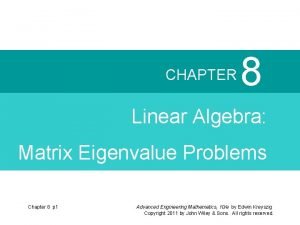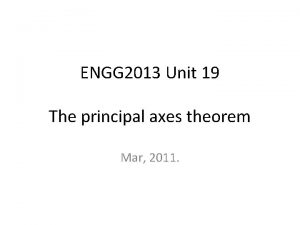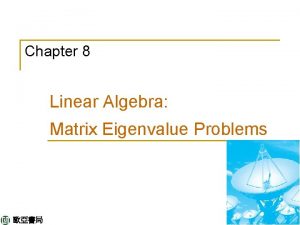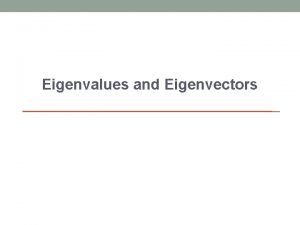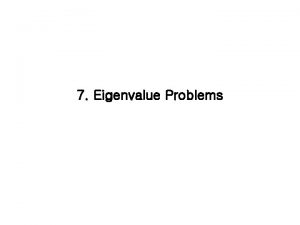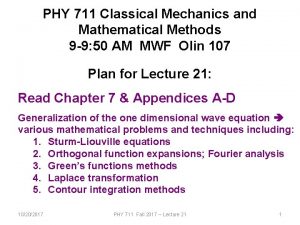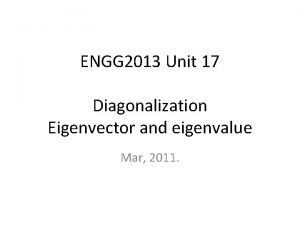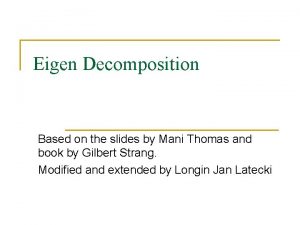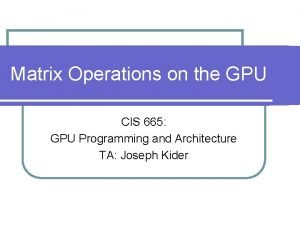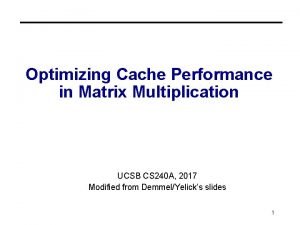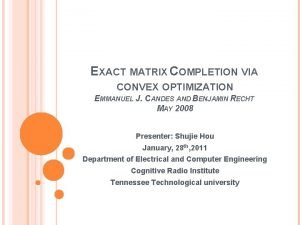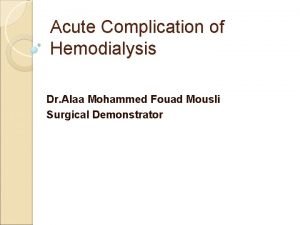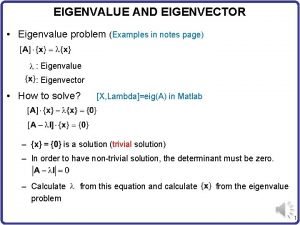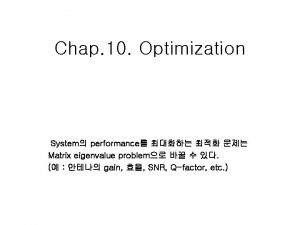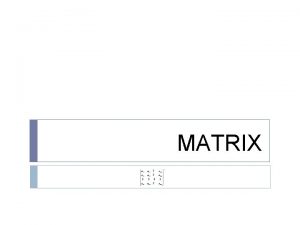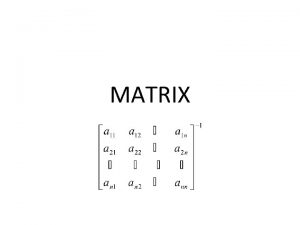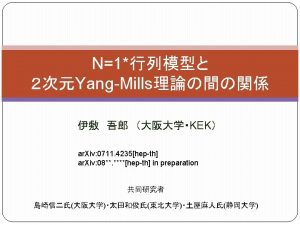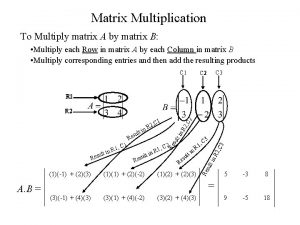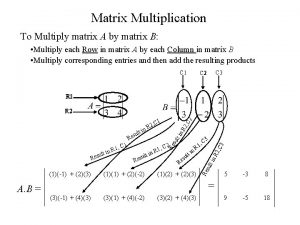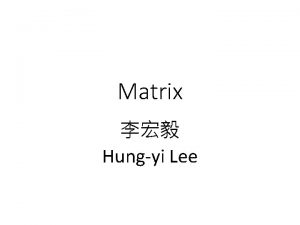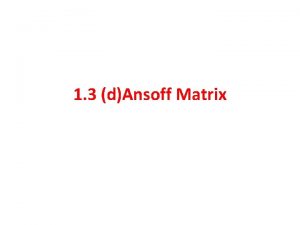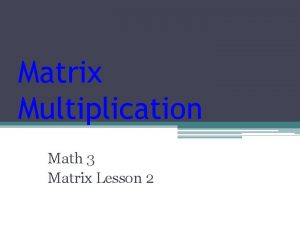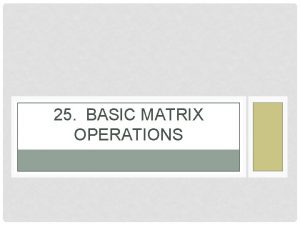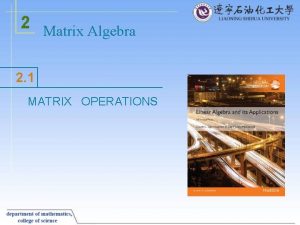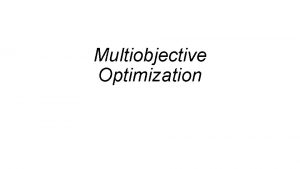A matrix generation approach for eigenvalue optimization Mohammad






























- Slides: 30

A matrix generation approach for eigenvalue optimization Mohammad R. Oskoorouchi California State University San Marcos, CA, USA International Conference on Continuous Optimization Rensselaer Polytechnic Institute August 2 – 4, 2004

Outline: • • Eigenvalue optimization From optimization to feasibility Weighted analytic center Recovering feasibility • Adding a p-dimensional matrix • Adding a column • Computational experience. • Future extensions

Eigenvalue optimization: Consider the following optimization problem:

Maximum eigenvalue function: • Continuous • Convex • nondifferentiable • nonpolyhedral cone • Cannot be written as the point-wise maximum of finite number of convex smooth function

The objective function can be cast as a semidefinite program: Now let be a feasible point and the maximum eigenvalue of has multiplicity , and be a matrix whose columns form a basis for the eigenspace for the maximum eigenvalue. By restricting to a subcone generated at the query point, we obtain a lower bound for




Let us study the inequality closely: or more

is represented by where

• is a compact convex set with nonempty interior, composed of linear and semidefinite inequalities. • contains the optimal solution set • is referred to as the set of localization

Weighted Analytic Center The weighted analytic is defined as the maximizer of the weighted dual potential function:

The primal formulation The weighted analytic center can be alternatively derived by the weighted primal potential function:

KKT optimality conditions

Approximate analytic centers

The primal directions:

Projection to the primal null space: This condition may not satisfy due to the computational round-off error. We therefore project the primal directions back to the primal null space.

Lemma

Recovering feasibility: So far, we reformulated the eigenvalue optimization problem into a convex feasibility problem, and derived a query point as an approximate analytic center of the set of localization: The eigenvalue function is evaluated at this point and there are two cases:

Adding a p-dimensional matrix: If f is not differentiable at the query point y, an oracle returns a subgradient of f at this point. The subgradient is in the form of semidefinite inequality and will be used to update the set of localization. Dual set of localization will be updated via

Illustration:

Primal set of localization: Due to computational difficulties with the deep cuts, in practice we use the primal set to recover centrality. We now need a strictly feasible point for the updated primal set of localization.

Primal updating direction: Implementing Newton method, one has

Primal updating direction: The objective function of this problem is composed of a quadratic term and a self-concordant function. Therefore, Newton method is suitable to solve this problem:

Primal updating direction: The Newton step d. T is obtained by setting the gradient of F(T+d. T) with respect to d. T to zero:

Adding a column:



Size m 50 200 Dimension n Density % Columns Matrices CPU time mm: ss 50 5 50 100 97 108 8 23 22 0 00: 24 00: 31 00: 00 300 5 50 100 76 87 50 34 04: 30 05: 56 500 5 50 100 99 66 75 42 54 53 12: 52 16: 31 11: 33 50 5 50 100 409 401 22 72 76 1 12: 45 10: 22 00: 06 200 5 50 100 326 323 184 106 108 55 36: 14 43: 22 10: 04 300 5 50 100 283 294 317 119 128 121 62: 49 83: 05 49: 12

Size m 500 800 1000 Dimension n Density % Columns Matrices CPU time mm: ss 10 5 100 88 23 0 0 02: 28 00: 39 20 5 100 203 30 0 0 06: 30 00: 51 50 5 100 1418 59 90 2 72: 05 01: 59 10 5 100 68 16 8 1 07: 50 01: 36 20 5 100 297 52 1 0 31: 23 04: 33 50 5 100 1311 73 99 0 438: 23 05: 08 10 5 100 57 27 12 2 12: 16 03: 07 20 5 100 231 56 13 0 45: 19 09: 24 50 5 100 1187 105 73 0 382: 10 17: 41
 Eigenvalue of 2x2 matrix
Eigenvalue of 2x2 matrix Eigenvalue of matrix 2x2
Eigenvalue of matrix 2x2 Eigenvalue of matrix 2x2
Eigenvalue of matrix 2x2 Eigenvalue from eigenvector
Eigenvalue from eigenvector Power method smallest eigenvalue
Power method smallest eigenvalue Eigenvalue
Eigenvalue Www.imageprocessingplace.com
Www.imageprocessingplace.com Eigenvalue examples
Eigenvalue examples Diagonalization of matrix
Diagonalization of matrix Eigenvalue definition
Eigenvalue definition Slides mani
Slides mani Stahl
Stahl You are good and your mercy endureth forever
You are good and your mercy endureth forever Cuda matrix multiplication optimization
Cuda matrix multiplication optimization Matrix multiplication cache optimization
Matrix multiplication cache optimization Exact matrix completion via convex optimization
Exact matrix completion via convex optimization Shaik mohammad tajuddin
Shaik mohammad tajuddin Sharif
Sharif Mohammad ali javidian
Mohammad ali javidian Dr nur mohammad hadi zahalan
Dr nur mohammad hadi zahalan Pearo-nn
Pearo-nn Dr mohammad khan
Dr mohammad khan Dr mohammad aman
Dr mohammad aman Dr mohammad aman
Dr mohammad aman Mohammad sharifkhani
Mohammad sharifkhani Mohammad sharifkhani
Mohammad sharifkhani Mohammad ghoreishi
Mohammad ghoreishi Wali mohammad md
Wali mohammad md Mohammad diab md
Mohammad diab md Mohammad sharifkhani
Mohammad sharifkhani Alaa mohammad fouad
Alaa mohammad fouad
